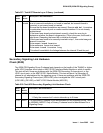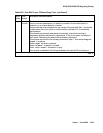
ISDN-TRK (DS1 ISDN Trunk)
Issue 1 June 2005 1447
Two types of DS1 interfaces exist:
● 24 DS0 channels on a 1.544-Mbps link
● 31 DS0 channels + 1 framing channel on a 2.048-Mbps link
On 24-channel interfaces, any of the first 23 ports on the DS1 circuit packs or media modules
can be a B channel. On the TN464C or higher suffix UDS1 circuit pack or MM710 Media
Module, the 24
th
port may be used as a B channel or as a D channel depending on the type of
ISDN-PRI signaling group (FAS or NFAS) implemented on the circuit pack or media module.
For more details, see ISDN-SGR (ISDN-PRI Signaling Group)
on page 1429. On the TN767
DS1 circuit pack, all 24 ports are used as B channels since D-channel signaling is not supported
on the TN767 circuit pack. The signaling for these B channels is done over a D channel located
on a UDS1 TN464C or higher suffix board.
On 32-channel interfaces, any of ports 1 – 15 and 17 – 31 on the DS1 interface circuit pack or
media module can be a B channel. The 16
th
port may be used as a B channel or as a D channel
depending on the type of ISDN-PRI signaling group (FAS or NFAS) to which it belongs. For
more details, see ISDN-SGR (ISDN-PRI Signaling Group)
on page 1429 and DS1-BD (DS1
Interface Circuit Pack) on page 978 or MG-DS1 (DS1 Interface Media Module) on page 1594.
For interfaces using country protocol 1 on the DS1 circuit pack or media module administration
form (including US), the signaling protocol used for the maintenance of the B channel is defined
by the Avaya ISDN-PRI specification. For interfaces using country protocols other than 1, the
signaling protocol used for the maintenance of the B channel is defined by the CCITT ISDN-PRI
Specification.
There are five possible service states for a B channel. The service state is negotiated with the
far-end switch, changes over time, and may have far-end and near-end components. The
service state is initialized to Out-of-Service/Far-End, and an attempt is made to negotiate it to
In-Service.
Note:
Note: A system technician can display the service state of a particular DS1 ISDN Trunk
B channel by issuing status trunk grp#/mem#.
When a call is present, the specification defines the permissible call states, as well. There are
tests in the short and long test sequences for DS1 ISDN Trunk designed to audit these states
and ensure agreement between both ends of the PRI connection.


















